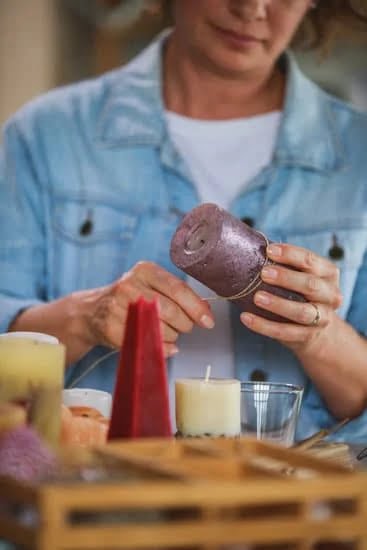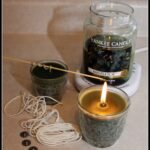During pregnancy, it is crucial for expectant mothers to prioritize their health and safety. As women embark on the journey of motherhood, they become more conscious of how their daily activities may impact their well-being, as well as that of their developing baby.
One common concern that arises is whether or not candle making is safe during pregnancy. This article will delve into the potential risks and provide research-backed evidence to help women make informed choices regarding candle making while pregnant.
Candle making has long been a cherished craft, allowing individuals to create customizable and aromatic pieces for ambiance and relaxation. However, in recent years, there have been apprehensions about the safety of engaging in this activity during pregnancy. Understanding the ingredients used in candle making and any potential risks associated with them becomes crucial for expectant mothers.
In this article, we will explore the harmful chemicals that can be found in candles and examine scientific findings on how these chemicals may impact pregnancy. Additionally, we will provide essential precautionary measures and guidelines for pregnant women who wish to participate in candle making safely. By understanding the potential risks and taking necessary precautions, expectant mothers can enjoy the craft of candle making without compromising their own safety or that of their unborn babies.
Understanding the Ingredients
As an expecting mother, it is essential to be aware of the potential risks and harmful chemicals that may be present in candle making. Understanding the ingredients used in candles can help you make informed choices to protect your health and the health of your baby.
When examining the ingredients used in candle making, there are a few key components to consider:
- Wax: The type of wax used in candles can vary, and some may contain harmful chemicals that could potentially pose a risk during pregnancy. Paraffin wax, for example, is derived from petroleum and can release toxic substances when burned, such as benzene and toluene. These chemicals have been linked to respiratory issues and are known carcinogens.
- Fragrances: Many scented candles contain synthetic fragrances that can emit volatile organic compounds (VOCs) when burned. VOCs can irritate the respiratory system and may also contribute to indoor air pollution. When pregnant, it is important to minimize exposure to these substances as much as possible.
- Dyes: Some candles are colored using dyes that may contain heavy metals or other potentially harmful additives. These additives could be absorbed through the skin or released into the air when burned, posing a risk to both you and your developing baby.
To ensure the safety of candle making during pregnancy, it is crucial to choose ingredients wisely. Consider opting for natural alternatives such as soy wax or beeswax instead of paraffin wax. These options are typically free from harmful toxins and do not release dangerous chemicals when burned.
Additionally, look for candles that use essential oils or natural fragrances derived from plant sources instead of synthetic fragrance oils. Natural fragrances tend to be milder and less likely to cause irritation or allergic reactions.
The Scientific Findings
Research has been conducted to investigate the potential impact of candle making on pregnancy. While there is limited direct research specifically focused on this topic, some studies have explored the effects of certain chemicals found in candles on reproductive health and overall air quality. Understanding these scientific findings can help pregnant women make informed decisions about engaging in candle making.
One area of concern is the release of harmful chemicals during the burning process of candles. Research has shown that some candles, especially those made from paraffin wax, can release toxic compounds such as benzene and toluene when burned. These compounds are known to be harmful and can negatively affect the respiratory system and overall health. Pregnant women should be cautious when using candles made from paraffin wax and consider alternatives that do not produce these harmful byproducts.
Another aspect examined by researchers is the effect of fragrance oils commonly used in candle making on pregnancy. Some fragrance oils contain phthalates, which are known endocrine disruptors and have been linked to adverse reproductive outcomes. Inhalation or absorption of these phthalates could potentially affect hormone levels and reproductive development in both the mother and fetus. It is recommended for pregnant women to opt for fragrance-free or naturally scented candles.
To minimize any potential risks associated with candle making during pregnancy, it is important for pregnant women to follow precautionary measures and guidelines. This includes ensuring proper ventilation in the workspace, wearing gloves when handling materials, avoiding prolonged exposure to fragrances or chemical fumes, and using natural or pregnancy-safe ingredients for candle making. Pregnant women should also consult with their healthcare provider before engaging in any craft activity to ensure personalized advice based on their individual health conditions.
In summary, scientific findings suggest that there may be potential risks associated with certain aspects of candle making during pregnancy, such as the release of harmful chemicals from burning candles and the use of fragrance oils containing phthalates. Pregnant women should exercise caution by selecting safer alternatives and following necessary precautions to minimize any potential harm.
Engaging in candle making during pregnancy is a personal decision, and it is advisable for pregnant women to carefully evaluate the risks and make informed choices based on their own health circumstances.
Precautionary Measures
Ensuring Proper Ventilation
One of the key precautionary measures for pregnant women engaging in candle making is ensuring proper ventilation. This is important because burning candles releases chemicals and toxins into the air, which could potentially be harmful to both the mother and the developing fetus.
To minimize exposure, it is recommended to work in a well-ventilated area, such as near an open window or using a fan to circulate the air. This helps to reduce the concentration of any volatile organic compounds (VOCs) that may be present in the air.
Choosing Safe Wax Options
The type of wax used in candle making can also play a role in safety during pregnancy. Certain waxes, such as paraffin wax, may release harmful chemicals like benzene and toluene when burned. It is advisable for pregnant women to opt for safer alternatives, such as soy wax, beeswax, or vegetable-based waxes, which are generally considered to be less toxic and emit fewer pollutants when burned.
Using Safe Fragrances
Fragrances are often added to candles to enhance their scent and create a pleasing atmosphere. However, some fragrances may contain phthalates, which have been linked to hormonal disruptions and developmental issues in babies. Pregnant women should choose fragrance oils that are phthalate-free or opt for natural essential oils instead. Before purchasing fragrance oils, it is important to read labels carefully and check for any potential harm or risks associated with their use during pregnancy.
Taking Safety Precautions with Dyes
If you choose to dye your candles while pregnant, it’s important to exercise caution with dye options as well. Some dyes may contain harmful substances that can be absorbed through the skin or released into the air when candles are burned. For a safer alternative, consider using natural dyes and colorants made from plant-based sources. These are generally considered to be pregnancy-friendly and less likely to pose any risks to both the mother and the baby.
Practicing Good Hygiene
During candle making, it is crucial for pregnant women to practice good hygiene to minimize potential risks. This includes washing hands thoroughly before and after handling any candle-making materials, such as wax, fragrances, or dyes. In addition, it’s important to avoid touching the face or mouth while working with these materials to prevent accidental ingestion or exposure.
By following these precautionary measures, pregnant women can enjoy the craft of candle making while minimizing potential risks to their health and that of their unborn child. However, it is always recommended to consult with a healthcare professional before engaging in any potentially risky activities during pregnancy.
Alternatives to Traditional Candle Making
With concerns about the potential risks and harmful chemicals found in traditional candle making, pregnant women may want to explore safer alternatives that are pregnancy-friendly. Fortunately, there are several candle crafting methods that can provide a safe and enjoyable experience for expectant mothers.
One popular alternative is using beeswax as the main ingredient for candle making. Beeswax is a natural and non-toxic substance that doesn’t release harmful toxins when burned. In fact, it has been found to emit negative ions that can help purify the air. Beeswax candles also have a longer burn time compared to other types of candles, making them a more sustainable choice.
Another option is soy wax candles. Soy wax is derived from soybeans and is considered to be environmentally friendly and renewable. It is free from toxins such as paraffin and lead, which can be harmful when inhaled or ingested. Soy wax candles also have a lower melting point, resulting in a cooler burn that reduces the risk of accidental burns.
A third alternative is using essential oils to create scented candles instead of synthetic fragrances. Synthetic fragrances often contain phthalates, which have been linked to endocrine disruption and other health issues. Essential oils, on the other hand, are derived from plants and offer natural aromas without the potentially harmful effects of synthetic fragrances.
| Alternative | Main Ingredient | Toxicity | Burn Time |
|---|---|---|---|
| Beeswax Candles | Natural beeswax | Non-toxic | Longer burn time |
| Soy Wax Candles | Soybeans | Non-toxic | Cooler burn |
| Essential Oil Candles | Essential oils | Non-toxic (depending on the oil used) | N/A |
These alternatives provide pregnant women with a range of options to continue enjoying the craft of candle making while prioritizing their safety and the health of their baby. It’s important to choose high-quality ingredients and follow proper candle making techniques to ensure a safe and enjoyable experience. By exploring these pregnancy-friendly methods, expectant mothers can create beautiful candles without compromising their well-being.
Expert Insights
Importance of Seeking Expert Guidance
When it comes to engaging in any activity during pregnancy, it is always a good idea to seek advice from medical professionals and obstetricians. Candle making is no exception. These experts play a crucial role in providing personalized guidance based on individual circumstances and ensuring the safety of both the mother and the baby. Their insights can help pregnant women make informed choices and assess potential risks.
The Role of Medical Professionals
Medical professionals and obstetricians are knowledgeable about the specific concerns and risks associated with candle making during pregnancy. They can offer advice tailored to each stage of pregnancy and provide information on avoiding harmful toxins or chemicals that may be present in candles. Furthermore, they can address any specific health conditions or complications that might affect a woman’s ability to engage in candle making safely.
It is important for pregnant women to schedule an appointment with their healthcare provider before embarking on any new activities, including candle making. This will allow them to discuss their plans, ask questions, and receive expert guidance on how to minimize potential risks.
Obstetrician Insights: Common Recommendations
Obstetricians often recommend following these guidelines when it comes to candle making during pregnancy:
- Opt for natural ingredients: Choose candles made from natural materials such as beeswax or soy wax rather than those containing synthetic fragrances or additives that may release harmful chemicals when burned.
- Ensure proper ventilation: It is crucial to work in a well-ventilated area while making candles to avoid inhaling fumes from melting wax or fragrance oils.
- Wear protective gear: Pregnant women should wear gloves and aprons when handling hot wax or potentially irritating substances like fragrance oils or dyes.
- Avoid excessive exposure: Limit the amount of time spent making candles in order to reduce prolonged exposure to chemicals, heat, and other potential hazards.
Following these general guidelines, along with any specific recommendations from one’s healthcare provider, can significantly contribute to a safe candle making experience during pregnancy.
Personal Experiences
One of the most valuable sources of information when it comes to pregnancy-related activities is firsthand experiences shared by other women. Hearing real-life stories and testimonials from pregnant women who have engaged in candle making can provide insight into the safety and potential risks associated with this craft during pregnancy.
Many pregnant women who have tried candle making during their pregnancy report positive experiences and no adverse effects on their health or the health of their baby. These women often describe candle making as a therapeutic activity that helps them relax, reduce stress, and express their creativity. They find joy in creating unique candles for themselves or as gifts for others, while also enjoying the soothing ambiance created by the candles they make.
While personal experiences may vary, it is important to note that some pregnant women may choose to take precautions during their candle making journey. For example, they may opt for natural and organic ingredients, such as soy wax or beeswax, instead of paraffin wax which can release potentially harmful chemicals when burned. They may also choose to work in a well-ventilated area to minimize exposure to any fumes that may be emitted during the melting and pouring process.
To illustrate the range of personal experiences with candle making during pregnancy, let’s take a look at some testimonials:
Testimonial 1:
“I absolutely loved candle making during my pregnancy. It became my go-to hobby whenever I needed some relaxation time. I used natural soy wax and essential oils for fragrance, and I never experienced any negative effects. It was such a rewarding experience to make customized candles for family and friends”.
Testimonial 2:
“I was initially hesitant about candle making during my pregnancy due to concerns about chemicals. However, after doing extensive research on safer ingredients and methods, I decided to give it a try. I incorporated safety measures like wearing gloves and working in a well-ventilated area. I’m happy to say that my candle making experience was enjoyable, and I had no issues throughout”.
Testimonial 3:
“Candle making was a wonderful creative outlet during my pregnancy. I switched to using natural beeswax candles and followed safety guidelines, such as avoiding overheating the wax. It was a relaxing and fulfilling hobby for me, and I never encountered any problems with my health or the baby’s well-being”.
These testimonials highlight the positive experiences of pregnant women who engaged in candle making while taking necessary precautions. However, it is important to remember that each pregnancy is unique, and it is crucial for expectant mothers to consult with their healthcare providers before engaging in any new activities or crafts.
| Testimonial |
|---|
| “I absolutely loved candle making during my pregnancy. It became my go-to hobby whenever I needed some relaxation time. I used natural soy wax and essential oils for fragrance, and I never experienced any negative effects. It was such a rewarding experience to make customized candles for family and friends.” |
| “I was initially hesitant about candle making during my pregnancy due to concerns about chemicals. However, after doing extensive research on safer ingredients and methods, I decided to give it a try. I incorporated safety measures like wearing gloves and working in a well-ventilated area. I’m happy to say that my candle making experience was enjoyable, and I had no issues throughout.” |
| “Candle making was a wonderful creative outlet during my pregnancy. I switched to using natural beeswax candles and followed safety guidelines, such as avoiding overheating the wax. It was a relaxing and fulfilling hobby for me, and I never encountered any problems with my health or the baby’s well-being.” |
Safe Candle Choices
When it comes to candle making during pregnancy, one of the most important considerations is selecting safe candles that do not pose any risks to the expectant mother or the developing baby. With so many different types of candles available in the market, it can be overwhelming to determine which ones are safe to use. In this section, we will provide a comprehensive guide on selecting pregnancy-safe candles and avoiding potentially harmful ones.
First and foremost, pregnant women should opt for candles made from natural and non-toxic materials. Avoid candles that contain paraffin wax, as they release harmful chemicals such as benzene and toluene when burned. Instead, look for candles made from natural waxes like soy wax or beeswax, which burn cleaner and emit fewer toxins.
Additionally, check for fragrances used in the candles. Many scented candles contain synthetic fragrances that can release harmful volatile organic compounds (VOCs) when burned. Pregnant women should choose unscented or naturally scented candles that use essential oils derived from plants.
Another important factor to consider is the wick material. Some wicks may be made from lead or other metals that can release toxins when burned. Look for candles with cotton or wood wicks instead, as they are safer options.
Furthermore, it’s crucial to read labels and packaging carefully before purchasing any candle. Look for certifications such as “non-toxic” or “lead-free” to ensure their safety during pregnancy.
Conclusion
In conclusion, it is important for pregnant women to make informed choices when engaging in the craft of candle making. While there are potential risks and harmful chemicals associated with certain ingredients used in candle making, there are also precautionary measures that can be taken to ensure the safety of both the mother and the baby.
By understanding the scientific findings and following essential safety tips and guidelines, pregnant women can enjoy the creative process of candle making without compromising their health.
Exploring alternatives to traditional candle making methods can also provide a safer option for pregnant women. By opting for pregnancy-friendly candle crafting methods, such as using natural and non-toxic materials, pregnant women can eliminate potential risks while still enjoying the therapeutic benefits of creating candles.
It is also crucial for pregnant women to seek advice from medical professionals and obstetricians regarding candle making safety during pregnancy. The expert insights provided by these healthcare professionals can offer valuable guidance on which precautions to take and which ingredients to avoid.
Ultimately, the goal is to empower pregnant women to make informed choices and prioritize their safety and the health of their baby when engaging in candle making. By selecting pregnancy-safe candles and avoiding potentially harmful ones, pregnant women can continue to enjoy this creative activity while ensuring a safe environment throughout their pregnancy journey.
Frequently Asked Questions
Are wax melts safe during pregnancy?
When it comes to wax melts, the safety during pregnancy largely depends on the ingredients used in the product. Generally speaking, wax melts that are made from natural ingredients such as soy or beeswax and scented with essential oils are considered safe.
However, it is important to read the label and ensure that there are no potentially harmful chemicals or synthetic fragrances added to the wax melts. Pregnant individuals should also be cautious about any specific scents that they may have sensitivity to, as strong fragrances might trigger nausea or headaches during this time.
Are fumes from candles harmful?
The fumes from candles can be potentially harmful depending on the type of candle being burned. Paraffin candles, which are commonly made from petroleum byproducts, can release toxins into the air when burned. These toxins include benzene and toluene, which are both known carcinogens.
Inhaling these fumes for extended periods may cause respiratory issues and other health problems. On the other hand, candles made from natural materials like soy or beeswax tend to produce fewer toxic fumes when burned. It’s always a good idea to choose candles with lead-free wicks and avoid burning them in an enclosed space without proper ventilation.
What scents are safe during pregnancy?
During pregnancy, some scents may be more tolerable than others due to changes in scent perception and increased sensitivity experienced by many pregnant individuals. Generally speaking, mild scents like lavender, chamomile, citrus fruits (such as lemon or orange), peppermint, and vanilla are considered safe during pregnancy and are less likely to trigger discomfort or adverse reactions.
However, every person’s tolerance towards certain scents can vary greatly during pregnancy, so it’s advisable to pay attention to individual responses and avoid any smells that cause nausea or irritate your senses. It’s always best to consult with a healthcare provider if you have concerns about particular scents during pregnancy.

Welcome to my candle making blog! In this blog, I will be sharing my tips and tricks for making candles. I will also be sharing some of my favorite recipes.





